Cutting-Edge Metal Fabrication Melbourne: Custom-made Solutions for Every Job
Cutting-Edge Metal Fabrication Melbourne: Custom-made Solutions for Every Job
Blog Article
Ingenious Trends in Steel Fabrication: Enhancing Longevity and Accuracy
In the realm of steel manufacture, the quest of sturdiness and accuracy has led to a wave of cutting-edge patterns that are improving the sector. From improvements in welding technologies to the assimilation of robotic automation in fabrication procedures, the landscape of steel manufacturing is developing swiftly. High-strength alloy advancement, paired with the use of 3D modeling and simulation software program, is pushing the borders of what is achievable in regards to architectural honesty and accuracy. The growing focus on lasting methods in steel manufacturing is not just driving performance but also cultivating a more ecologically mindful method to manufacture. These trends are not just forming the here and now yet also laying the foundation for the future of steel manufacture, guaranteeing additional improvements in sturdiness and accuracy.
Advanced Welding Technologies
In the world of steel manufacture, the fostering of advanced welding innovations has dramatically changed the industry's approach to achieving superior high quality and accuracy in structural welds. Advanced welding modern technologies, such as laser light beam welding and rubbing mix welding, have actually become game-changers in the field. Laser light beam welding uses a concentrated laser light beam to join metal parts with impressive accuracy and rate, making it ideal for intricate designs and slim products. On the other hand, rubbing stir welding creates exceptionally solid bonds by mechanically intermixing the particles of the products at the joint, getting rid of the demand for melting the metal. These innovations supply various advantages, consisting of reduced heat-affected zones, minimal distortion, and boosted mechanical homes in the welded joints. By leveraging these innovative welding strategies, steel producers can boost the toughness, stamina, and precision of their architectural welds, fulfilling the significantly requiring requirements of modern construction tasks.
Robotic Automation in Manufacture
Embracing robotic automation has ended up being a keystone of modern steel construction techniques, streamlining procedures and boosting performance throughout the sector. Robots are revolutionizing the method steel elements are produced, offering unequaled accuracy and rate while reducing human error. These automated systems can deal with repetitive tasks with constant precision, resulting in better output.
One key advantage of robotic automation in steel manufacture is the ability to work around the clock without tiredness, considerably raising manufacturing result. This continual procedure decreases downtime and speeds up task timelines, inevitably conserving prices for suppliers. In addition, robots can be configured to carry out elaborate tasks that might be harmful or difficult for human workers, improving safety in the office.
Additionally, robotic automation allows smooth assimilation with various other electronic technologies, such as computer-aided style (CAD) software program and Internet of Points (IoT) systems (metal fabrication melbourne). This interconnected approach improves interaction in between different phases of fabrication, enhancing operations and ensuring real-time tracking and control. As the steel construction market remains to advance, robot automation stands apart as a transformative force driving effectiveness and precision in producing procedures

High-Strength Alloy Development
The advancement of high-strength alloy advancement in steel manufacture is improving the market's method to boosting product sturdiness and performance. High-strength alloys are crafted to show superior mechanical properties, such as raised tensile toughness, sturdiness, and deterioration resistance contrasted to conventional steel grades. By incorporating these advanced alloys into manufacture procedures, manufacturers can generate elements that stand up to higher stress degrees and extreme settings, leading to more trusted and resilient end products.
One key benefit of high-strength alloy advancement is the ability to minimize product thickness without compromising architectural stability. try this web-site This not only causes lighter-weight parts however also adds to set you back financial savings and enhanced efficiency in manufacture and assembly procedures. In addition, the improved strength-to-weight ratio of these alloys permits the design and building and construction of structures with greater load-bearing capabilities while minimizing total weight.
3D Modeling and Simulation Software Program
Developments in steel construction processes have been substantially thrust by the integration of advanced 3D modeling and simulation software devices. These tools enable makers to develop detailed digital versions of their projects, allowing them to picture the last product with precision before any kind of physical job starts.

Sustainable Practices in Steel Production
Integrating sustainable techniques right into steel production procedures is necessary for reducing environmental effect and making certain long-lasting source accessibility. One vital lasting technique is the adoption of energy-efficient innovations to lower greenhouse gas exhausts throughout the steel manufacturing procedure. This consists of using renewable resource sources, such as solar or wind power, to power steel plants and applying energy-efficient devices to optimize power use.
Another vital facet of lasting steel manufacturing is the liable sourcing of raw materials. This includes ensuring that the iron ore and other resources utilized in steelmaking are obtained from ecologically friendly and ethical sources. By advertising openness in the supply chain and sticking to stringent ecological criteria, steel manufacturers can reduce the unfavorable impacts of resource removal on regional ecosystems and neighborhoods.

Verdict
Finally, the innovative trends in steel construction such as advanced welding modern technologies, robotic automation, more info here high-strength alloy development, 3D modeling and simulation software, and sustainable methods are improving the durability and accuracy of steel products. These advancements are changing the steel fabrication click for more info industry by improving efficiency, quality, and sustainability. It is clear that the future of steel manufacture lies in embracing these cutting-edge innovations to meet the needs of contemporary building and construction and production industries.
In the realm of steel fabrication, the search of toughness and precision has actually led to a wave of innovative fads that are improving the industry.In the world of steel manufacture, the fostering of advanced welding modern technologies has substantially transformed the sector's strategy to attaining remarkable top quality and precision in structural welds. As the steel construction industry continues to evolve, robot automation stands out as a transformative pressure driving efficiency and precision in making procedures.
Moreover, reusing and reusing steel scrap and waste products play a considerable duty in enhancing the sustainability of steel production. Alpha reo.In conclusion, the innovative patterns in steel manufacture such as advanced welding technologies, robot automation, high-strength alloy development, 3D modeling and simulation software application, and sustainable techniques are improving the durability and precision of steel items
Report this page